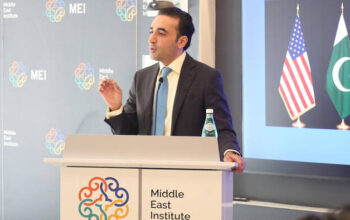As the flood of inflation threatens to turn into a tsunami, a highbrow expert has called for an end to the rupee free float.
By Ahmer Kureishi
June, the final month of the last fiscal year saw wholesale inflation in Pakistan rise to a historic high of 38.9 percent per annum, giving rise to fears that the flood of consumer price inflation is about to turn into a tsunami. Already at this point, the consumer price index was at 21.32 percent per annum.
What is more – as if things were not bad enough – many among the keener observers of the country’s economy looked at the numbers published by the Pakistan Bureau of Statistics (PBS) with scepticism.
The slightest interrogation of the field data cited by the report would be enough to bring out the glaring inconsistencies that cannot be explained away.
The price of a 20kg flour bag in Peshawar, for instance, was quoted as PKR 998 at one outlet while everywhere else in the city it was more than PKR 1,600. The lower of these was lower than anywhere in the wheat-growing Punjab province, which is simply not possible.
While the domestic academics left the matter rest for obvious reasons, a strong voice on the international stage has risen to challenge the picture painted by the officials.
In tweet posted from his verified handle Thursday, Steve Hanke – a professor of applied economics at the Johns Hopkins University in Baltimore, Maryland – said he measured (consumer price) inflation in Pakistan at a whopping 42.597 percent per year, twice the official number.
Prof Dr Steve Hanke is also a senior fellow and director of the Troubled Currencies Project at the libertarian Cato Institute in Washington, DC, and co-director of the JHU’s Institute for Applied Economics, Global Health, and the Study of Business Enterprise in Baltimore, Maryland.
Interestingly enough, Hanke does not stop at making known his assessment of the extent of the malaise. He goes on to lay down a very specific prescription to cure it: Abolish the central bank and institute a currency board.
Hanke is a currency reformer known for his work in several countries including Albania, Argentina, Bulgaria, Bosnia and Herzegovina, Ecuador, Estonia, Indonesia, Jamaica, Kazakhstan, Lithuania, Montenegro, Russia, Venezuela, and Yugoslavia, according to Wikipedia.
“He was a senior economist with President Ronald Reagan’s Council of Economic Advisers from 1981 to 1982, and has served as an adviser to heads of state in countries throughout Asia, South America, Europe, and the Middle East”, says the open sources encyclopaedia.
“He is also known for his work on currency boards, dollarization, hyperinflation, water pricing and demand, benefit-cost analysis, privatization, and other topics in applied economics.”
Currency boards have fallen out of fashion over the last several decades for being a throwback to the colonial era, when a colonised people’s monetary unit would be pegged to the colonising power’s currency.
This anchoring of the currency is one of the three key characteristics of the currency board system. The other two are automatic convertibility of the domestic currency at anchor rate to the foreign currency to which it is anchored; and a long-term commitment to the system, often enshrined in the central bank law.
The main reason for countries to contemplate a currency board is to pursue a visible anti-inflationary policy.
Hanke has been called “a modern-day crusader of inflation tracking and currency boards” for his contribution to a renewed interest in the system. A strong advocate of a return to the system as a means to avert hyperinflation, he has devised an inflation tracking tool called Hanke’s inflation tracker.
Hanke’s inflation tracker uses a fundamentally different approach to measuring inflation.
The conventional approach to measuring inflation involves collection of price data for select commodities from the market and assigning weightage to each commodity proportionate to its importance to a typical consumer.
These weighted prices are then incorporated into a consumer price index, revealing a typical consumer’s average cost of living. Any movements of this index indicate by how much the cost of living has gone up or down.
The international best practice requires data collection for computing the consumer price index collected through periodical surveys.
It is obvious that this methodology is riddled with glaring loopholes that can result in inaccuracies in measuring inflation. For one thing, the data collection agents can allow errors to creep in though their omissions and commissions.
Equally, in accuracies in assigning weightage to various commodities can further skew the index. Finally, there is the temptation for officials to manipulate numbers to show a low inflation rate, which would validate their policies irrespective of their actual success.
It has been reported that Argentina manipulated data during 2007 to 2015 to consistently report inflation at a lower level than its actual magnitude. But Argentina is unlikely to be the last country to find this strategy expedient.
Hanke’s methodology uses the purchasing power parity or PPP theory to calculate inflation and has bene recognised by several experts to be quicker, more accurate, less error prone, more convenient, and less costly.
Based on a macroeconomic approach, it uses the balance sheets of the central bank and commercial banks to arrive at the money supply – and he predicates his case for currency boards on these aggregate inflation numbers.
Hanke has been credited with being the “the architect of currency boards” in Estonia, Lithuania, Bulgaria, and Bosnia-Herzegovina. And he it was who helped Bulgaria navigate back to calmer waters from peak hyperinflation of 242 percent in 1997 after becoming the chief advisor to president Petar Stoyanov.
If you look closely, Hanke’s case for currency boards is essentially a case against free floating currency, a move Pakistan made under the government of former Prime Minister Imran Khan. The slide of rupee that started with the move and has been responsible for much of the economic hardship seen by the people of Pakistan since shows no sign of stopping.
Prof Hanke says developing countries facing increased risks of hyperinflation need to consider radical preventative measures including currency boards before it is too late.
According to him, developing countries have two options: Dollarization or a currency board system.
Dollarization is the use of a sound foreign currency and no local currency. Although dollarized monetary regimes exist in 37 countries today, the solution does not look much attractive for Pakistan. That leaves us with the currency board system.
The second option – issuing local currency via a currency board – involves local currency trading at a fixed exchange rate with a sound anchor currency. Fully backed with anchor currency reserves, the local currency remains pegged to the anchor currency under this system.
July is well underway and with it the tide of inflation is rising to crushing effect. It remains to be seen how much those at the helm of affairs are responsive to the plight of the common citizen – and how much they feel empowered to take bold decisions.
For, there is no denying that the ill-timed rupee free float has been the bane of Pakistan’s economy multiplying our external debt and import bill, eroding the value of the rupee, and eating away at the common citizen’s purchasing power.
Copyright © 2021 Independent Pakistan | All rights reserved




